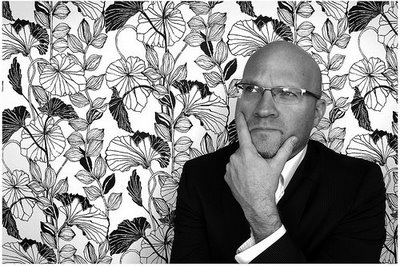
Adam Lerner, MCA Denver’s Animator
“The board set me up in a really great way,” Adam Lerner told me by telephone from Denver the first week of June. He was referring to the MCAs decision, when they invited Lerner to be director, to effect a merger between the downtown contemporary museum, and Lerners last squeeze, the LAB at Belmar.
(The LAB, no longer a physical locale, had been a contemporary art center in a new-urbanist development in Denvers western exurbs. The developer fit the LAB into the mix alongside bowling alley. movie theater, and upscale shopping, hoping it would make Belmar a destination. But that didnt happen.)
One of the immediate effects of MCAs hiring Lerner and incorporating the Labs programs under their shingle was that the popular Mixed Taste lecture series, of which Lerner was instigant and emcee, now take place at MCA. In early June, Lerner was getting his feet under him at a museum that bills itself as “a museum without a front door-a place for public engagement.” His impression was that things were going great.
Still, to backtrack a few paces, many in the community have found MCA sterile and inaccessible. Over at Belmar, Lerners Mixed Taste was famous for yucking it up during evenings in which unlikely duos gathered to talk meat sausage and T.S. Eliot, tattoo art and Ibsen, followed by shuffleboard, darts and dinner for the 20- and 30-somethings in the crowd. It might be that constituency who believe Lerner is just the impresario needed to lead Denvers contemporary art museum, which shows work both by international and regional contemporary artists, into a populist future. But he has his detractors.
Westword art critic Michael Paglia has written hes afraid Lerners going to dumb down programming. (Below: Andrew Novick show at Belmar.) Still, in the period since Lerners been the brains of the museum, the first Mixed Taste series at MCA sold out, with more than 330 people attending. The chief animator explained he is looking to capitalize on that success by exploring options to expand program capacity.

Andrew Novick's show at Belmar
Back when the LAB was operational, the idea was that the developed community of Belmar itself would feed in audiences. But actually the audiences were driving out from the city: Some 60 percent came from Denver, with the rest coming from nearby. Lerner allowed that the LAB, “in a more conventional setting” (than downtown Denver), was experimental, and laid the foundation for now.
“I learned a lot, but Im not going to continue what I did there, whole quaff.” Lerner allowed, “The LAB provided me a venue to try and fail.”
“The Astounding Problem of Andrew Novick” was one example Lerner gave of his being his own biggest critic. The exhibit showed the collections of a Denver object- obsessive whose mania for multiples in everything from Barbie dolls to gumball prize made up the show. While that exhibition at the LAB received the most media attention of any Lerner-generated exhibit, Lerner says it taught him a lot about how an institution represents non-art objects. Because Mr. T. figures and flea-market paintings of cat faces werent fine art, Lerner sidelined the exhibit into a gallery outside the main space, something he said he wouldnt likely do again.
“Id like to invest more and make a truly artful and elevated presentation of these ideas. It pulled my punch a little.”
Echoing the “museum without door” PR of MCA, Lerner said, “Often, institutions divide the front door experience — and call it marketing– and the gallery experience — and call it curating. Its all woven together. The MCA building is really a theatrical experiment that doesnt distinguish whats inside from whats outside. It incorporates it all into the whole aesthetic experience.”
Lerner wants to incorporate the museums passageways, halls and the library to create a more holistic creative experience of contemporary art-going. Still, he reiterates that the core backbone of the institution are shows of work by important contemporary artists–but he wont be directly organizing these.
So, while his role is to breathe new life into the institution, he doesnt want to play dual roles of curator and director that his MCA predecessor Cydney Payton filled. Lerner is looking to hire a curator, “Im putting together a creative team. Im the artistic director. My role is not to make sure the art goes on the wall, my role is to create a vibrant experience for the visitor.”
In the meantime he is working with independent curators like Paul Andersen, design critic at the Harvard Graduate School of Design who will produce a show on the history of pattern and design.
He also confessed that MCA will play a key role in the upcoming Denver Biennial by hosting a large-scale exhibition as well as coordinating several satellite projects. Lerner wouldnt confirm that Tim Noble, Sue Webster and David Adjaye will be involved, but their recent presence in Denver for the Logan lecture series, with Suzanne Geiss of Deitch Projects, suggest that is possible.
Lerner has stepped up into national lanes already. He participated at a May 15 panel discussion in New York at MOMA. And he is taking Mixed Taste to Deitch Projects in July, while Mark Allen, director of Machine Project, is coming to Denver to study the integration of creative programming into MCA.
